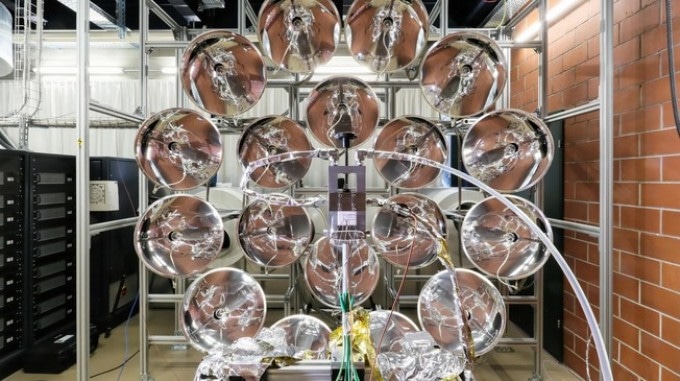Sep 22 2016
An EPFL laboratory has developed a new system replicating almost several thousand times the sun’s radiation received on earth. This new system was developed by arranging 18 light sources in a half-sphere to obtain this equivalent with unmatched precision and power. The system is suitable for testing a wide range of materials and solar power equipment in intense heat conditions and temperatures, thus providing a complete picture within just a few hours without the vagaries of the weather. Optics Express recently published a report on this topic.
 Eighteen light sources arranged in a half-sphere (Copyright 2016 Alain Herzog)
Eighteen light sources arranged in a half-sphere (Copyright 2016 Alain Herzog)
The intensity of 21,700 suns
This new system was developed in collaboration with the company Kinoton Digital Solutions and the Australian National University. It was designed to create the most intense light possible that can be modified accurately and does not produce unnecessary heat, as this could damage the materials that are tested. To obtain this, the team placed 18 light sources in two concentric circles surrounding a virtual half-sphere almost two meters in diameter. A reflector, which is a type of cup-shaped mirror, was present in each of these lamps. This reflector was lit by a Xenon bulb. The light waves produced by the bulb and spread to all directions are reflected and focused on a particular point. The maximum intensity reaches 21,700 suns (21.7 MW m-2) at the spot where the light beams from varied lamps meet. This is the spot that the testing of devices and materials is possible.
The system is huge, it occupies an entire room at the Laboratory of Renewable Energy Science and Engineering (LRESE). It can also be used to perform a variety of tests under controlled and stable experimental conditions. The research group led by Sophia Haussener uses this system for the group’s work on new techniques for transforming and storing solar energy. For instance, the researchers test the transfer of heat between different materials, which could enhance the output from commercial concentrating solar power plants (tower or cylindro-parabolic forms, both of which are increasingly being used in Spain and the United States) or illustrate the possibility of new approaches to harness, transfer and transform light energy. Currently, a number of collaborative efforts for characterizing space materials are under way.
A versatile current that changes everything
A new type of reflector, developed through electroforming, played a vital role in contributing to the system’s exceptional performance.
This is a method for the electrolytic deposition of metal, and it can replicate a model with unparalleled exactness. The precision of reflection is much better.
Gaël Levêque, a scientist at LRESE.
An increasing number of modules are available in comparison to the existing solar simulators and the current can also be modified, highlighting the possibility of monitoring the amount of power. The lamps receive current that can be dialed anywhere from 70% to 120% of the 90 injected amps, thus making it possible to monitor the amount of luminous power that is being delivered. The researcher has a number of choices for a given level of power or flux:
To get 5.4 KW in power, for example, we can use six lamps – in other words just the first circle of lamps – at 120%, or nine lamps at 70%.
Levêque.
Using fewer lamps “closes” the angle of incidence of the radiation, which highlights that the total light beam is more powerful and narrower. An increase in the number of lamps highlights that the beam will turn out to be less concentrated and wider, which indeed is practical for lighting a surface in a more uniform manner.
A twin in Australia and an open-source method
Another similar system like this new one developed by EPFL was built at the same time in Canberra, Australia. However, this system in Australia is more than just a system. It is an open-source method developed by the researchers in association with their colleagues at the company Kinoton Digital Solutions GmbH and the Australian National University. It is thus possible to build other systems on the basis of these calculations, and also by using fewer or more lamps and varied dimensions. It is also possible to obtain stronger radiative fluxes by modifying a number of parameters or using more powerful lamps.